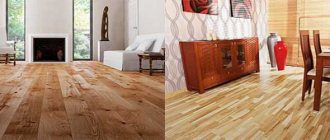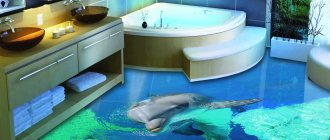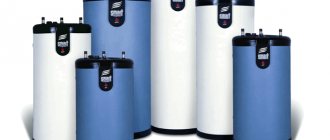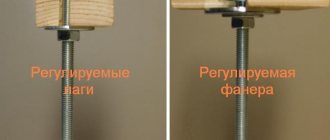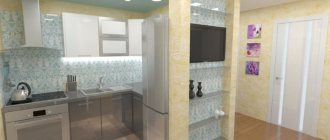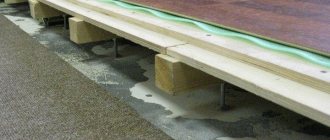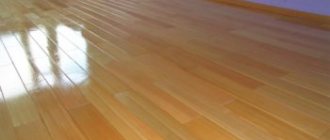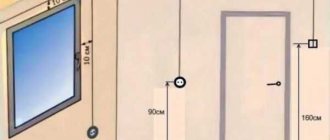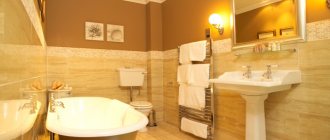03/18/2016 master
The corridor in any apartment or house is an integral part of the room. Since this is where apartment guests begin to form an opinion about the owner, many strive to make this room not only practical and functional, but also beautiful. A great way to add some flair to your hallway is to add floor lighting.
But in order to do everything right, you need to know certain nuances, which our article will tell you about.
Madam hallway
It is always problematic to make repairs in the corridor, since this room often has non-standard dimensions and is often “broken” by small passages. The hallway is characterized by the following aspects, which to a certain extent may complicate the creation of lighting:
Corridor option
- small dimensions;
- wrong proportions. in the corridor you can often find various niches for built-in cabinets, bends and other architectural nuances necessary for moving between rooms;
- narrowness of space. Since the hallway is not intended for people to stay in it for a long time, but only for their more or less comfortable movement around the apartment, its width can often only accommodate one person of average build;
- problematic design of lighting.
Note! It is especially problematic to provide high-quality lighting in a long and narrow hallway. Here, high wardrobes can provide adequate lighting.
Therefore, before you begin selecting lighting fixtures for this room, you need to carefully think through and weigh everything. And for this you need to know what kind of lighting should be present in the corridor to create the necessary level of lighting in it. This is especially true when you decide to highlight the floor.
Basic mistakes
When organizing lighting systems in the corridor, try to pursue several goals at once. There is no need to focus solely on the brightness of the lighting. Don't forget about adjusting the room: a classic chandelier that looks great in a large hall will look awkward in a small and narrow corridor. In addition to attracting unnecessary attention, the device also focuses attention on the shortcomings of a secluded space. Combine different scenarios to fix an error like this.
Most often, when arranging lighting systems for corridors, owners of apartments and private houses make the following mistakes:
- insufficient lighting level;
- going overboard with the number of light sources (excessive brightness);
- choosing inappropriate fixtures (a chandelier that is too large for a small corridor or, conversely, lamps that are too compact for a spacious hall);
- incorrect placement of devices (incorrect choice of installation location).
Any mistake leads to excessive attention focused on the shortcomings of the room associated with its dimensions, architecture, shape and features. You need to act in such a way as to hide them.
Rules for the hallway
Floor lighting is a rather non-standard solution, but in recent years it has increasingly begun to be used in the corridor. This is due to many nuances of this room, as well as the features of its architecture. To ensure your floor lighting is effective, the following aspects need to be considered:
- lamps that will be used here as lighting must be reliably protected from dust and moisture. In the hallway, especially in autumn, winter and spring, puddles of dirt may appear, flowing from seasonal shoes. If moisture gets on the lamps, they may begin to work incorrectly or even lead to a short circuit. In addition, wet cleaning, often carried out in the hallway, can also lead to the troubles described above. By the way, summer dust from shoes, although it does not have such a catastrophic effect on lighting fixtures, can also negatively affect their operation.;
- The housing lighting elements must have special mechanical protection. Especially if the distance from the floor to the lighting fixtures is not large;
Protection of lamps
- efficiency of light bulbs. Today in the world there are trends towards rational saving and recycling of household items in a new role (the same hand-made, for example). Therefore, many people prefer modern light bulbs, which can significantly reduce energy consumption without loss of light characteristics;
Note! At the moment, LED lamps and luminaires are the most popular. They are the most economical because they consume the least amount of electricity. Their installation will save approximately 80% compared to a conventional incandescent light bulb.
- Another important parameter for choosing lighting fixtures is their fire hazard. Lamps must be made of non-flammable materials, and when exposed to open fire, they must not emit toxic and dangerous compounds into the air;
- the luminous flux that the lamps form should not blind the eyes. It is better to choose warm shades close to sunny yellow. It is this color spectrum that is most optimal for our eyes and closest to natural light.
Also, quite often, lamps in the corridor at floor level or slightly higher are used to create night lighting for the room. In such a situation, the light emitted by lighting fixtures should be soft and subdued.
A little about saving
Motion Sensor
If you want to minimize energy losses in your home, then to illuminate the floor in the hallway you need to use lighting fixtures with a motion sensor built into it.
The peculiarity of this kind of products is that they are activated and turn on the light only if there is movement of an object in the room. In this case, the motion sensor can be configured so that it does not react to pets (cats, dogs, etc.). As a result of the settings, you can improve the ergonomic parameters of the device, eliminating its activation when registering an object of low mass or in the presence of slight movement. Installing such a sensor will give you the following benefits:
- automation of lighting switching. In such a situation, you no longer need to fumble around the wall in search of the switch. This will save your renovation much longer, and will also make moving around the house more comfortable;
- minimizing energy losses. Since the light will automatically turn on and off only when there is or is no movement, you simply will not forget to leave it on.
Today, sensors that respond to movement in a given area can be of the following types:
- infrared;
- microwave;
- sound;
- combined.
Types of sensors
Infrared motion sensors are the most popular in the home today. They give the minimum number of false inclusions, and are also relatively affordable.
In turn, combined models can completely eliminate the risk of incorrect operation due to the presence of two diverse sensors in their composition, but they are much more expensive. The remaining types are most often used outdoors, although they can also be found indoors.
Lighting options
As you know, the lighting market is currently quite diverse. But it can also be roughly divided into six options, which will fit perfectly into the hallway area as floor lighting:
- Spotlights;
- neon lamps;
- LED strips;
- LED duralight;
- flexible neon;
- light floor
To understand the features of each backlight option, we will consider them separately and in more detail.
Spot devices
Spotlights
One of the popular lighting devices often found in the hallway are spotlights. This is the easiest and most affordable way to organize floor lighting in the corridor. They are built-in devices, so they are installed in specially prepared holes in the side walls or laminate flooring.
The best option for placing such lighting would be to install it along the entire perimeter of the corridor. If the room has a wardrobe and other furniture, then such lamps are built in on the side of the free wall. The advantages of such lighting include:
- product tightness;
- impact resistance;
- attractive appearance. Such lighting fixtures can act as an additional decorative decoration for the hallway, which will give it a zest and special sophistication;
- long service period;
- Possibility of installing energy-efficient light bulbs.
It is also worth noting that these lamps have excellent moisture resistance. Therefore, they will be an ideal option for organizing lighting not only in the hallway, but also in the bathroom and kitchen.
Installation
Buy wires with a reserve so that in the future you can gradually increase the number of devices. Place lighting devices on both sides of the room. Push-button and key switches are obsolete, replace them with motion sensors.
Study the sanitary standards for indoor lighting; they were created to maintain health. Shadows cast from lamps can be reduced by cascading them.
Step-by-step instruction
Let's look at the instructions for connecting pass-through switches. This scheme will allow you to control lighting devices from two places independent from each other. Wired switches have three contacts for connection. One of the contacts is common, two are separate.
Our circuit consists of several pass-through switches, a small lamp, connecting wires, and a junction box. All connections are made in the box and the power wire from the distribution panel is located.
A wire with brown insulation is a phase, and a wire with blue insulation is a zero.
A wire with white insulation is connected to the common contact; this is done on both sides. When connecting, the phase always goes not to the lamp, but to the switch, this is a classic rule. The phase goes into the circuit break, the zero is connected to the lamp.
- 1 Step
We connect the zero that came from the distribution panel via the power cable to the zero of the lamp.
- 2 Step
The phase from the distribution panel is connected to the common contact of the wired switch (white insulation wire).
- 3 Step
We connect wires with red insulation to the same wires, and do the same with green wires.
- 4 Step
We connect the common contact of the first pass-through switch (white insulation wire) to the lamp.
It is not difficult to assemble this circuit at home. Two switches are located at the beginning and at the end of the hallway. You come home, press the switch, the lamp lights up. They took the necessary things, came to the other end of the corridor, turned off the light. You can turn the lighting device on and off from any side, the circuit will work.
Neon lamps
Another classic way to create lighting is neon lamps. Such products create an even and softly flowing light.
Neon lamp
The neon lamp itself consists of the following components:
- the lamp itself;
- wires;
- special convector.
Therefore, in this case, only a hidden version of the backlight is allowed, where all the components of the device are hidden in a special niche. Neon lamps, just like spotlights, should be placed around the perimeter of the room. As a result, the entire corridor will be flooded with pleasant light. The advantages of such lighting include:
- long service life, which will be more than 10 years;
- availability of a large selection of lighting colors;
- pleasant lighting.
But in addition to the advantages, there are also some disadvantages:
- high fragility of lamps;
- quite high cost;
- the presence of a certain negative effect on the human body.
In addition, installing such lighting on your own will be problematic. This is where you need the help of a professional. And these are additional costs.
Do you need a luminous baseboard?
The luminous plinth performs both practical and decorative functions. The practical function is to create additional evening or night lighting, the decorative function is to create a special atmosphere in the room.
Peculiarities:
- Glowing baseboards are made using LED lighting.
- The small light bulbs that it consists of are unusually bright, durable, do not heat up, are economical and safe, and can be installed anywhere.
- To organize a luminous baseboard, illuminated floor planks are produced.
Both solid light strips and spotlights of various colors can be mounted in them. If desired, you can make such a plinth yourself by laying a light strip in the cable channel of special plinths.
LED strips
LED Strip Light
This type of lighting fixtures is as popular as spotlights. Moreover, in the living room or bedroom they often act in tandem as main and additional lighting. The same situation is relevant in the case of the hallway. LED strips are energy-saving light sources, which is another reason for their popularity in home lighting.
This lighting fixture consists of the following parts:
- the tape itself;
- power unit;
- remote control and controller (as additional accessories). With their help you can create multi-mode lighting.
Such a light source will be an excellent replacement for fragile neon lamps that are unsafe for human health. The advantages of tapes include:
- ease of installation;
- high energy efficiency indicators;
- the presence of a wide range of colors;
- long period of work;
- possibility of installing hidden and non-hidden lighting.
As you can see, using LED strip has many advantages.
Light as a means of correcting proportions
The hallway and corridor often have an unfortunate shape. The room can be long, narrow, cramped. These shortcomings can be corrected with lighting. Here are some standard situations and ways to solve them:
- Long elongated hallway. Particular emphasis is placed on lighting the walls. Lamps can be located on the walls or ceiling, but the light from them should be directed towards the top of the walls. This effect will help visually make the room wider. The effect will be even greater if one of the long walls is decorated with a mirror, preferably the entire wall. A non-standard approach to lighting a loft-style hallway
- In hallways with curves, you can use lamps of different types, but of the same style. With this technique we achieve zoning and an unsuccessful layout turns into a highlight.
- If the hallway is small and the flow is high, you need to visually “lower” the ceilings. For this purpose, lamps use directional light with a small scattering angle. The light should be directed onto the walls and floor, and the ceiling should remain in shadow.
- You can visually increase the height of the room with the help of a brightly lit white ceiling. In this case, the lamps also need directional light, but they should direct the buds of the rays to the ceiling.
These tricks really work and solve two problems at once: they illuminate and correct the shape of the room. You just need to choose the right light sources.
LED duralight
LED duralight
This lighting device acts as an alternative to LED strips and neon lamps. Duralight has the form of a transparent PVC tube in which LEDs are installed at equal distances.
The advantages of such a lamp include:
- availability of various colors;
- soft and high-quality lighting;
- the presence of several types of duralight modifications (two- or three-wire).
The design of the lamp has a plug with which it is connected to the power supply network.
Circuit diagram of an analog night light controller
And for old-school radio amateurs who do not want to mess with the MK, we present an analog alternative with a similar effect: only 2 capacitors, a resistor and a field-effect transistor, which will smoothly light up the LED after a second, shine for a minute, then go out to zero after 30 seconds and remain in standby mode consuming only a few microamps.
Flexible neon
Flexible neon
This lighting device is a cross between a neon lamp and an LED strip. The design resembles duralight: a PVC tube in which LEDs are placed. But the difference is that the light they emit is neon.
The advantages of such a lamp include the ability to lay it not only along a rectangular area (unlike neon lamps), but also in any other variation. At the same time, you can safely do everything yourself without turning to a specialist for help. Flexible neon has a high service life (up to 100,000 hours), but this can be reduced if used or installed incorrectly.
Light floor
The term “light floor” refers to luminous floor modules.
Light floor
Such modules can be installed either in a chaotic manner or along the entire perimeter of the hallway. The advantages of this option include:
- high moisture resistant properties;
- high shockproof qualities.
With the help of such modules you can create a special room design. But remember not to overdo it here. Such a floor in several modules is more suitable for a spacious corridor than a narrow hallway. It should be noted that light floors are used extremely rarely at home. Most often it can be found in nightclubs and on dance floors, where they act as an element of the interior of dance floors.
